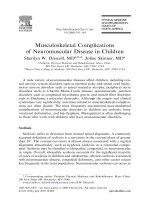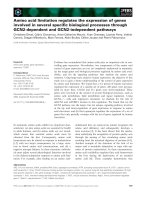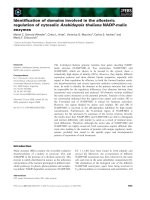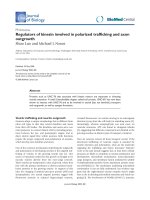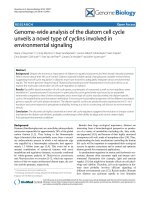Self-reported prevalence musculoskeletal pain/discomfort of farmers involved in potato cultivation activities: An ergonomic study
Bạn đang xem bản rút gọn của tài liệu. Xem và tải ngay bản đầy đủ của tài liệu tại đây (153.35 KB, 4 trang )
Int.J.Curr.Microbiol.App.Sci (2019) 8(3): 2206-2209
International Journal of Current Microbiology and Applied Sciences
ISSN: 2319-7706 Volume 8 Number 03 (2019)
Journal homepage:
Original Research Article
/>
Self-Reported Prevalence Musculoskeletal Pain/Discomfort of Farmers
involved in Potato Cultivation Activities: An Ergonomic Study
Katayani1*, Aradhana Kushwaha1, Dipika Schan1 and Rekha Dayal2
1
Department of FRM, 2MAB College of Home Science, C.S.A.U.A. & T., Kanpur, India
*Corresponding author
ABSTRACT
Keywords
Ergonomic, WorkRelated MSD,
Nordic
Musculoskeletal
Questionnaire
Article Info
Accepted:
18 February 2019
Available Online:
10 March 2019
A part from cereal production (rice, wheat, etc.) agricultural labourers is engaged in
vegetable Cultivation in, Kannauj, India. Potato cultivation is one of the important
vegetable cultivation in India. The potato cultivation tasks are repetitive in nature and
those are carried out mainly by manual efforts. Most of the tasks of potato cultivation are
monotonous, strenuous, physiologically demanding as well as time-consuming. Present
study entitled “Musculoskeletal Discomfort of Farmers involved in Potato Cultivation
Activities: An Ergonomic Study” Potato cultivation is a physically arduous occupation that
places potato growers in potential risk of musculoskeletal disorders, which impose a
greater impact on their health. To assess musculoskeletal discomfort among potato
growers, NORDIC (1987) standardized questionnaire designed for the analysis of
musculoskeletal discomfort of complete body parts with special reference to low back,
shoulders and neck. Multistage purposive random sampling technique was followed to
select the state, district, blocks and finally respondents. District Kannauj is purposively
selected as this is one of the largest potato producer districts while two blocks namely
Kannauj and Jalabad were randomly selected. Two villages from each selected block i.e.
Basirapur and Mahmoadpur paith from Kannauj and, Badlepurwa and Kheda from
Jalalabad, selected randomly. Forty farmers from each selected village, Total sample size
160 respondents were randomly selected for final data collection. Maximum
pain/discomfort was reported in lower back. Majority respondents felt pain that sustained
for more than 12 hours in different body parts i.e. neck, shoulders right and left, elbows,
wrist/hands, and ankles/feet. More than sixty five per cent respondents were suffering from
gastric or other abdominal issues and cataract while 50.62 percent respondents found
suffering from Anemia disease. Sixty nine per cent respondents were injured as a result of
home/farming accidents, whereas 54.37 percent respondents injured due to cut or hit as a
part of activity like hand/foot cut with sickle or spade etc.
Introduction
India is primarily an agrarian economy as
farming is one of the most important
occupations in the country and agriculture
sector is the prime mover of economic growth
2206
Int.J.Curr.Microbiol.App.Sci (2019) 8(3): 2206-2209
in Uttar Pradesh. A vast majority of the
population in the state virtually relies on the
agriculture for its livelihood. As high as 65 per
cent of the total workforce in the state depends
on the agriculture, most of whom are below
poverty line. Besides this, most of the
agricultural activities are carried out mainly
through manual efforts. The global area under
potato during 1998 was about 18 million ha
with a total production of about 295 million
tonnes. U.P. is the major potato growing state
in India followed by West Bengal and Bihar
with the production of 10455.30, 7482.30 and
1720.20 thousand tones, respectively. The
highest productivity of the crop is in West
Bengal followed by Gujrat. In respect to Uttar
Pradesh, Kannauj district is the highest
producer of potato followed by Farrukhabad
and Agra with the production of 942299,
832744 and 647025 metric tonnes and area
being 34595, 29793and 18156 hectares,
respectively. But in average productivity (q.
/ha) district Agra first having place (356.37)
followed by Mathura (339.37 q/ha) and
Rampur (336.49 q/ha) (Anonymous 20012002).Pain, discomfort and loss of function in
the back, neck and extremities are common
among working people. These ailments are
commonly termed musculoskeletal disorders
(MSDs). So, the WMSDs are defined as
impairments of bodily structures such as
muscles, joints, tendons, ligaments, nerves or
the localized blood circulation system that are
caused or aggravated primarily by the
performance of work and by the effects of the
immediate environment in which work is
being carried out. Most work-related MSDs
are cumulative disorders, resulting from
repeated exposure to high- or low-intensity
loads over a long period of time. However,
MSDs can also be acute traumas, such as
fractures, that occur during an accident. The
symptoms may vary from discomfort and pain
to decreased body function and invalidity.
Although it is not clear to what extent MSDs
are caused by work, their impact on working
life is huge. MSDs can interfere with activities
at work, and can result in absence from work
and chronic occupational disability. The
consequences
may
include
decreased
productivity, a financial burden for the
worker, for society and social disadvantages
for the work.
Materials and Methods
The study was conducted in Kannauj district
of Uttar Pradesh during the year 2015. The
pre-coded interview schedule was constructed
in order to elicit information needed to obtain
the objectives of the study. Multistage
purposive random sampling technique was
followed to select the state, district, blocks and
finally respondents. District Kannauj is
purposively selected as this is one of the
largest potato producer districts while two
blocks namely Kannauj and Jalabad were
randomly selected. Two villages from each
selected block i.e. Basirapur and Mahmoadpur
paith from Kannauj and, Badlepurwa and
Kheda from Jalalabad, selected randomly.
Forty farmers from each selected village,
Total sample size 160 respondents were
randomly selected for final data collection.
Results and Discussion
(66.25%) respondents accepted that they had
pain in neck during last year, which lasted for
at least 12 hours while more than ninety per
cent respondents agreed that they had pain in
neck in last month that remain for at least 12
hours More than seventy per cent respondents
were found having pain in right shoulder that
lasted for at least 12 hour in previous year,
whereas about eighty eight per cent
respondents accepted pain in right shoulder
that lasted for at least 12 hours in previous
month. About ninety one per cent respondents
suffered pain in left shoulder that lasted for at
least 12 hours in previous week. A little less
than eighty five per cent respondents accepted
2207
Int.J.Curr.Microbiol.App.Sci (2019) 8(3): 2206-2209
feeling of pain in right elbow that continued
for at least 12 hours in last year while about
eighty one per cent respondents felt pain in
right elbow that sustained for at least 12 hours
in previous month. Seventy five per cent
respondents accepted pain in both elbow that
lasted for at least 12 hours in last 12 months
while 62.50 percent and 87.50 percent
respondents complaint pain in both the elbows
which lasted for at least 12 hours in previous
months and last seven days respectively
(Table 1).
Table.1 Distributions of Respondents on the Basis of Self-Reported Prevalence of
Musculoskeletal Pain/Discomfort
N=160
S.
No
.
Body
part
1
Neck
2
Shoulder
Right
Pain/discomfort during last 12
month lasting for at least 12
hours
NO
YES
Left
Both
3
Elbow
Right
Left
Both
4
Wrist/hands
Right
Left
Both
5
6
7
8
9
Upper
back
Lower
back
Hips/thig
hs
Knees
Ankles/
feet
Pain/discomfort during
last month lasting for at
last12 hours
NO
YES
Pain/discomfort during
last
Seven days lasting for at least 12
hours
NO
YES
54
(33.75)
106 (66.25)
12 (07.5)
148 (92.5)
107 (66.87)
53 (33.12)
45
(28.12)
145
(90.62)
141
(88.12)
115 (71.87)
20 (12.50)
140 (87.5)
82 (51.25)
78 (48.75)
15 (09.37)
105
(65.62)
106
(66.25)
55 (34.37)
81 (50.62)
145 (90.62)
54.00 (33.75)
10 (06.25)
150.00 (93.75)
25
(15.62)
11
(06.87)
40
(25.00)
135 (84.37)
11
(06.87)
58
(37.25)
17
(10.62)
130
(81.25)
120
(75.00)
135
(84.37)
130
(81.25)
40
(25.00)
19 (11.87)
31 (19.37)
135 (84.37)
25 (15.62)
149 (93.12)
129
(80.62)
31 (19.37)
129 (80.62)
95 (59.37)
65 (40.62)
120 (75.00)
60 (37.50)
100 (62.5)
20 (12.50)
140 (87.5)
149 (93.12)
58 (36.25)
102 (63.75)
37 (23.12)
102 (63.75)
102
(63.75)
37 (23.12)
123 (76.87)
11 (06.87)
149 (93.2)
143 (89.37)
40 (25.00)
120 (75.00)
64 (40.00)
96 (60.00)
30 (18.75)
50 (31.25)
110 (68.75)
110 (68.75)
50 (31.25)
40 (25.00)
85 (53.12)
75 (46.87)
107 (66.87)
53 (33.12)
25 (15.62)
56 (35.00)
79 (49.37)
81 (52.50)
30 (18.75)
104
(65.00)
132 (82.5)
28 (17.50)
91 (56.87)
69 (43.12)
120 (75.00)
50 (31.25)
110 (68.75)
79 (49.37)
81 (50.62)
Above ninety per cent respondents reported
pain in right wrist that sustained for at least 12
hours during last 12 months. A little less than
ninety per cent respondents accepted the
feeling of pain in both the writs/hands which
lasted for at least 12 hours in last 12 months
2208
Int.J.Curr.Microbiol.App.Sci (2019) 8(3): 2206-2209
and seventy five per cent respondents were
suffering pain in both the hand which
continued at least for 12 hours in last month.
Sixty per cent respondents were having pain
in both wrists/hands during last seven days
which lasts for at least 12 hours, whereas,
little less than seventy per cent respondents
having pain in upper back which sustained for
12 hours in last month. More than forty five
per cent respondents reported pain in lower
back that sustained for at least 12 hours in last
month. Majority (84.37%) respondents did
not complain any pain in hips/thighs that last
for at least 12 hours in during last 12 month
and More than eighty one and 82.50 per cent
respondents were not having pain in knees
which continued for at least 12 hours.
Majority (75.00%, 68.75%) and 50.62%) of
respondents were having pain which sustained
for more than 12 hours in last 12 month, last
month and last seven days respectively.
Musculoskeletal discomfort felt at Upper back
and elbows were also negatively correlated
with age of the respondents. Positive
significant relationship was observed between
age of the respondents and musculoskeletal
pain/ discomfort reported in neck, shoulder,
low back and wrist/hand.
In conclusion, the potato cultivation tasks are
repetitive in nature and those are carried out
mainly by manual efforts. Most of the tasks of
potato cultivation are monotonous, strenuous,
physiologically demanding as well as timeconsuming. The prevalence of MSDs was
very high among the workers and the most
affected areas were back and upper extremity.
Postural analysis indicated that the subjects
had to adopt different stressful postures
during performing different potato cultivation
jobs. During potato cultivation operations the
workers were subjected to greater postural
stress. Postural stress might be the reason of
the occurrence of MSDs. From this study it
has been recommended that workers should
avoid bad work postures as far as possible
during work for reducing job related health
hazards.
References
Anonymous. (2001-02) All India Coordinated
Research Project in Home Science:
Annual Report, ICAR, New Delhi,
India.
Osborne, A.; Blake, C.; McNamara, J.;
Meredith, D. and Phelan, J. (2010)
Musculoskeletal disorders among Irish
farmers. Occup Med (Lond) 60: 598603.
Kuorinka, B.; Jonsson, A.; Kilbom, H.;
Vinterberg, F. and Andersson, K.
(1987)
Standardized
Nordic
questionnaires for the analysis of
musculoskeletal symptoms. Applied
Ergonomics. 18(3): 233-237.
How to cite this article:
Katayani, Aradhana Kushwaha, Dipika Schan and Rekha Dayal. 2019. Self-Reported
Prevalence Musculoskeletal Pain/Discomfort of Farmers involved in Potato Cultivation
Activities: An Ergonomic Study. Int.J.Curr.Microbiol.App.Sci. 8(03): 2206-2209. doi:
/>
2209


